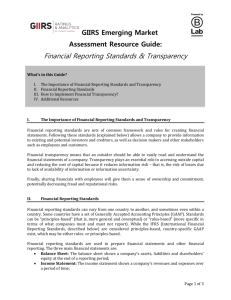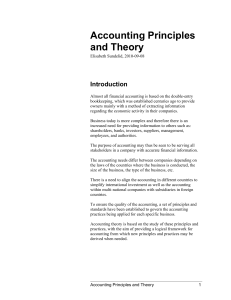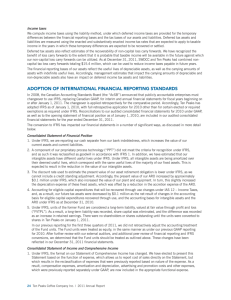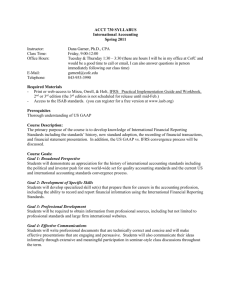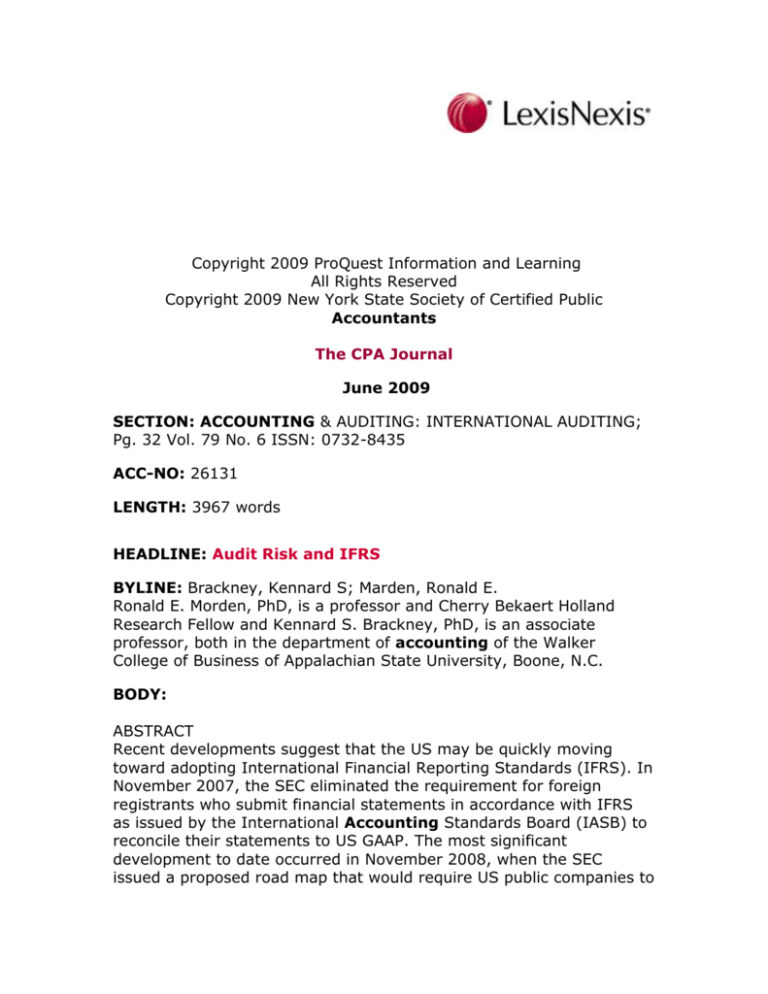
Copyright 2009 ProQuest Information and Learning
All Rights Reserved
Copyright 2009 New York State Society of Certified Public
Accountants
The CPA Journal
June 2009
SECTION: ACCOUNTING & AUDITING: INTERNATIONAL AUDITING;
Pg. 32 Vol. 79 No. 6 ISSN: 0732-8435
ACC-NO: 26131
LENGTH: 3967 words
HEADLINE: Audit Risk and IFRS
BYLINE: Brackney, Kennard S; Marden, Ronald E.
Ronald E. Morden, PhD, is a professor and Cherry Bekaert Holland
Research Fellow and Kennard S. Brackney, PhD, is an associate
professor, both in the department of accounting of the Walker
College of Business of Appalachian State University, Boone, N.C.
BODY:
ABSTRACT
Recent developments suggest that the US may be quickly moving
toward adopting International Financial Reporting Standards (IFRS). In
November 2007, the SEC eliminated the requirement for foreign
registrants who submit financial statements in accordance with IFRS
as issued by the International Accounting Standards Board (IASB) to
reconcile their statements to US GAAP. The most significant
development to date occurred in November 2008, when the SEC
issued a proposed road map that would require US public companies to
convert to IFRS. Although management compliance with IFRS will
become easier given the flexibility these standards offer, the audit
process will likely become more complex. US GAAP generally includes
not only accounting principles and practices, but also the "methods"
of applying them (AU 410, Adherence to Generally Accepted
Accounting Principles), and IFRS is no different. IFRS and US GAAP
employ a similar notion of fair value.
FULL TEXT
Does Increased Flexibility Increase Audit Risk?
Recent developments suggest that the United States may be quickly
moving toward adopting International Financial Reporting Staridards
(TFRS). In November 2007, the SEC eliminated the requirement for
foreign registrants who submit financial statements in accordance with
IFRS as issued by the International Accounting Standards Board
(IASB) to reconcile their statements to U.S. GAAP. In May 2008, the
AICPA voted to add the IASB to the approved list of accounting
standards-setting bodies, effectively giving private companies the
option to use IFRS.
The most significant development to date occurred in November 2008,
when the SEC issued a proposed road map that would require U.S.
public companies to convert to IFRS. The proposal would permit
approximately 110 of the largest U.S. -listed companies to early adopt
IFRS for 2009 annual filings. IFRS could be mandatory as early as
2014 if certain milestones were to be met by 2011. The milestones
include continued improvement of IFRS, revamping of the funding
mechanism for IASB operations, and significant progress in the
training of U.S. accountants and stakeholders on the IASB standards.
A considerable amount of information is currently available regarding
how IFRS and U.S. GAAP differ. The IASB's website
(http://www.iasb.org/) offers a detailed summary of each standard,
and, other sites, such as Deloitte's IAS Plus (www.iasplus. com),
provide helpful tabular summaries on the major differences between
IFRS and U.S. GAAP. There has been a limited amount of research,
however, on how the adoption of IFRS in the United States would
affect the work of independent auditors. Changing to IFRS will impact
the audit function and has the potential for increased audit risk as a
result of iinplementation.
IFRS and a Rush to Increasing Judgment
Some members of the Public Company Accounting Oversight Board's
(PCAOB) Standing Advisory Group (SAG) are worried that a rapid
move to IFRS may overly burden accounting professionals who are
already strapped for resources, and these SAG members question
whether the IFRS financial reporting framework is of high enough
quality to meet the U.S. regulators' and investors' expectations (Sarah
Johnson, "PCAOB Told to Plan for Global Standards," CFO.com,
October 18, 2007, http://www.cfo./?m/artcle.cfm/10005769?
f=search).
One of the underlying concerns from SAG members is that allowing the
widespread use of IFRS may lead to dis- agreements between auditors
and manage- ment about whetiier a company used prop- er judgment
This issue arises from the idea diat because IFRS is more flexible - that
is, more principles-based tiian U.S. GAAP, which is generally
considered more rules- based - it allows more judgment by management in deciding how they will comply with IFRS. The SarbanesOxley Act of 2002 (SOX) mandated that die SEC conduct a study on
the merits of principlesbased standards. The SEC issued its report in
July 2003, expressing support for what it called "objectives-based"
standards. While a gradual shift to principles-based standards has
begun, the SEC's proposal to require adoption of IFRS by U.S.-listed
companies within the next few years could dramatically speed up this
transition.
Although management compliance with IFRS will become easier given
the flexibility these standards offer, the audit process will likely
become more complex. Auditors will now have the difficult task of
trying to assess management's judgments on IFRS compliance and the
"spirit of the law" rather than assessing compliance based on the
established U.S. GAAP set of benchmark rules. Allowing such flexibility
may result in a "your judgment against my judgment" standoff
between management and auditors. Such a state could lead to
increased audit risk if the auditors unknowingly fail to appropriately
modify their opinion on financial statements that are materially
misstated. This increase in audit risk is due, in part, to the fact that
auditors will be involved in assessing an unfamiliar and seemingly
more flexible set of standards that could offer company executives
more leeway for managing income.
This is a substantial change for auditors, and, according to Timothy
Flynn, chairman of KPMG International, change can be complicated
("U.S. Warming to IFRS as it Moves on from GAAP," Financial Times,
September 4, 2008, http://www.ft.com// cms/s/0/e944709e-7a 1 911 dd-bb93 000077bO7658.html). Moving to IFRS will not only affect
companies' information systems and financial reporting processes, but
also their contractual and compensation arrangements and even their
training (particularly for boards of directors and audit committees).
IFRS certainly will change the current dynamic between auditors and
preparers in the United States. Given that IFRS is less prescriptive
than U.S. GAAP, companies will need to produce more detailed and
specific disclosures to help explain the presentations and judgments
they have made, and auditors may no longer have a detailed set of
rules for measuring conformity with IFRS (e.g., the absence of "brightline" numbers for identifying a capital lease).
Additionally, U.S. GAAP generally includes not only accounting
principles and practices, but also the "methods" of applying them (AU
410, Adherence to Generally Accepted Accounting Principles), and
IFRS is no different. Consequently, if the rules for establishing
conformity with financial reporting are reduced or eliminated, it may
become even more difficult for auditors to challenge management's
judgments on the methods used to apply the predominantly principlesbased IFRS.
According to the IAS Plus website, 115 countries either require or
permit use of IFRS by listed companies. A recent survey by Deloitte
("2008 IFRS Survey: Where Are We Today?" May 2008,
www.feloitte.?m/dtt/cda/doc/?ntentms_a
ssurance_IFRS_2008%20IFRS%20Survey. pdf) found that 40% of the
Fortune Global 500 companies are already using IFRS. From the sheer
volume of non-U.S. companies using these standards, one might
assume that the United States should be able to implement IFRS
smoothly as well. Foreign companies have acquired a capacity to make
the needed judgments, and auditors have developed an ability to
examine the resulting financial statement assertions. It is important,
however, to proceed with caution. Cultures and legal systems vary
significantly from one country to the next. Many foreign countries do
not have an authoritative system of oversight or the disciplinary
capacity that the SEC and PCAOB have in the United States. The
seemingly successful implementation of these standards in other
countries might be a reflection of weaker oversight and regulation of
the financial reporting and external audit functions. With its more
litigious environment, and its historically strong affinity for rules-based
standards, the United States, and auditors in particular, may find the
conversion to IFRS to be more of a challenge than observed in other
countries.
In the United States, upon a company's adoption of IFRS, the auditor's
report will need to identify those circumstances in which reporting
principles have not been consistently observed in the current period
with respect to the preceding period (AU 420, Consistency of
Application of Generally Accepted Accounting Principles and IFRS).
The first year that a company switches to IFRS will certainly entail a
major change in reporting (more than simply a change from one GAAP
treatment to another). While the consistency of reporting over several
years may be partly overcome simply by restating prior periods as
required by IFRS 1 (First-Time Adoption of International Financial
Reporting Standards), this may be problematic, for example, when
testing the valuation assertions on fair value for prior periods,
particularly in cases where there were no established markets. Such a
situation could arise if a company elects under IFRS 1 to restate all
business combinations prior to the IFRS adoption date. Again, this
could leave a wide margin for judgment and potentially subjective
manipulation of the financial statements - in other words, increased
risk. Auditors will look to reduce these risks by collecting evidence to
test the assertions made by management and support the auditor's
opinion.
Audit Evidence and Managements Assertions
Whether a company is publicly traded or privately held, auditors will
likely have to follow the AICPA's AU 360 on audit evidence (accepted
by the PCAOB as an interim standard to be followed if the client is
publicly traded) or the PCAOB's currently proposed standard on audit
evidence (part of the PCAOB's suite of new auditing standards related
to the auditor's assessment of and responses to risk and related
conforming amendments). These standards remind auditors that they
must obtain sufficient, appropriate audit evidence by perfoiming audit
procedures that will provide a reasonable basis for an opinion
regarding the financial statements under audit.
One of the PCAOB's proposed standards is "Audit Risk in an Audit of
Financial Statements." This statement defines audit risk as the risk
that the auditor expresses an inappropriate audit opinion when the
financial statements are materially misstated. This is a function of the
risk of material misstatement and detection risk.
The risks of material misstatement (at the assertion level) consist of
the following components:
Inherent risk. This refers to the susceptibility of an assertion to a
misstatement due to error or fraud that could be material, either
individually or in combination with other misstatements before the
consideration of any related controls.
Control risk. This is the risk that a misstatement due to error or fraud
could occur in an assertion that could be material, either individually or
in combination with other misstatements, and that might not be
prevented or detected on a timely basis by the company's internal
control. Control risk is a function of the effectiveness of the design and
operation of internal control.
Inherent risk and control risk are the company's risks; they exist
independently of the audit.
Detection risk. This is the risk that the procedures performed by an
auditor will not detect a misstatement that could be material, either
individually or in combination with other misstatements. Detection risk
is a function of the effectiveness of an audit procedure and of its
application by the auditor. The level of detection risk is reduced
through the performance of substantive procedures. For a given level
of audit risk, the acceptable level of detection risk bears an inverse
relationship to the risk of material misstatement at the assertion level.
The greater the risk of material misstatement, the less detection risk
can be accepted.
As an example, estimation accounts-such as accounts needing fair
value assessments-are inherently more risky than most other
accounts. Accounts in which judgment is used in the application of
significant accounting principles, especially those used for
determining management's estimates and assumptions (e.g., in fair
value accounting), are addressed in the proposed PCAOB standard
"Identifying and Assessing Risks of Material Misstatement." Because
this will be new territory for auditors, and because they will be making
these risk assessments based on a new reporting standard (IFRS),
they must also follow the PCAOB' s proposed standard on "The
Auditor's Responses to the Risks of Material Misstatement." Particularly
with an inherently risky area, such as fair value accounting, auditors
must ensure that the knowledge, skill, and ability of engagement team
members with significant responsibilities are commensurate with the
risks of material misstatement and provide the appropriate level of
supervision. The auditor must also evaluate whether the company's
selection and application of significant accounting principles (i.e.,
IFRS), particularly those related to subjective measurements and
complex transactions, indicate a bias that could lead to material
misstatement of the financial statements. If auditors believe there is a
potential bias and risk of material misstatement, they must lower their
detection risk and adjust the nature, timing, and extent of their
substantive procedures.
Ultimately, an entity's financial statements are the responsibility of
management. Management is responsible not only for the fair
presentation that reflects the nature and operations of the entity, but
also for ensuring the statements are in conformity with a financial
reporting framework, be it U.S. GAAP or IFRS. In doing this,
management implicitly or explicitly makes assertions regarding the
recognition, measurement, and presentation of information in the
financial statements and related disclosures. Auditors collect evidence
to test these assertions by using professional judgment and exercising
professional skepticism in evaluating the quantity and quality of audit
evidence, and thus its sufficiency and appropriateness, to support the
audit opinion (AU 360).
Based on the authors' conversations with audit partners and
managers from several of the largest public accounting firms,
perhaps the biggest problems facing auditors when financial
statements are presented using IFRS may be the assertions regarding
valuation, particularly fair value. In addition, in PCAOB Staff Audit
Practice Alert No. 3, "Audit Considerations in the Current Economic
Environment" (December 5, 2008), the PCAOB explains that recent
events in the financial markets and the current economic environment
may affect companies' operations and financial reporting and, in turn,
may have implications for audits of financial statements and internal
control over financial reporting. Audit risks that may have been
previously identified may become more significant or new risks may
exist due to current events (e.g., those affecting the economy, credit
and liquidity). Among other things, the current uncertainties in the
market and economy may create questions about the valuation,
impairment, or recoverability of certain assets and the completeness
or valuation of certain liabilities reflected in financial statements.
Fair Value Measurement in IFRS
In SFAS 157, Fair Value Measurements, FASB defines fair value as the
exit price for an asset or liability, preferably a market-based exit price.
SFAS 157 gives a hierarchy for establishing fair value that prioritizes a
quoted market price for an identical item. When a quoted market price
for an identical item is unavailable, companies must look to otiier
market-based inputs to form a reasonable estimate of fair value. In
the absence of otiier market-based inputs, companies may apply their
own assumptions about how market participants normally price such
items. (The current financial crisis has prompted questions about the
determination, even the relevance, of fair values for financial
instruments in distressed or inactive markets. For more on these
concerns, see "The Role of Mark-to-Market Accounting in the
Financial Crisis," The CPA Journal, January 2009.)
The IASB does not currently have an equivalent to SFAS 157, though it
is moving quickly to establish comparable guidance as part of its
convergence program. The IASB expects to issue a final standard on
fair value measurement in 2010. In response to the financial crisis, as
an interim measure, the IASB is taking steps to improve company
disclosures on fair value measurements of their financial instruments.
Specifically, in March 2009, the IASB issued Improving Disclosures
about Financial Instruments (amendments to IFRS 7, Financial
Instruments: Disclosures), which adopts the fair value measurement
hierarchy given in SFAS 157 and requires companies to disclose
information about their use of each of the three levels of inputs for
determining fair value. The amendments are effective for annual
periods beginning on or after January 1, 2009.
IFRS and U.S. GAAP employ a similar notion of fair value. The main
way in which these two reporting systems differ is in the specific items
to which fair value measurement must be, or may be, applied. The
Exhibit provides a summary of the key differences in use of fair value
reporting between IFRS and U.S. GAAP. This analysis identifies the
IASB statements mat require or permit fair value reporting and
compares the IFRS treatment to U.S. GAAP. It views fair value broadly
to include measurements determined as of the reporting date and
measurements that use market inputs. Of the existing IASB standards,
13 differ in the use of fair value reporting from US. GAAP. The analysis
found 19 total differences in these standards. For 15 of the 19
differences, IFRS requires or permits the use of fair value reporting in
situations where U.S. GAAP does not. In contrast, there are just four
cases where U.S. GAAP requires or permits fair value reporting and
IFRS does not.
With the issuance of SFAS 159, The Fair Value Option for Financial
Assets and Financial Liabilities, U.S. GAAP now offers the option of
using fair value for certain financial assets and liabilities. IFRS grants a
fair value option for a wider range of assets, including property, plant,
and equipment (IAS 16); intangible assets (IAS 38); and investment
properties (IAS 40). IFRS also requires fair value measurement for
certain items where U.S. GAAP does noL such as financial instruments
issued to a related party (IAS 32), investments in private entities (IAS
39), and biological assets (IAS 41). Furthermore, due to differences in
the details of standards, BFRS is more likely to result in the use of fair
value measurement for certain items, such as inventories (IAS 2);
individual elements in multiple-element arrangements (IAS 18); and
components of hybrid financial instruments (IAS 39).
The potential for assets and liabilities that are not traded in public
markets to be reported on a fair value basis is greater under IFRS than
under U.S. GAAP. Items for which IFRS requires measurement at fair
value but a quoted market price is unlikely to be available include
investments in private entities (IAS 39); financial instruments that
qualify as derivatives under IFRS, but not under U.S. GAAP (IAS 39);
and biological assets (IAS 41). Items for which IFRS provides the
option for fair value measurement but a quoted market price is
unlikely to be available include property, plant, and equipment (IAS
16) and investment properties (IAS 40). In addition, recognition of
impairment losses, which requires a write-down to the higher of fair
value less cost to sell or present value, is much more likely under IFRS
(IAS 36).
What all this means is that the application of these fair value principles
under IFRS would require a company's management to use
considerable judgment in making estimates about the future, and the
role of valuation experts in the preparation of financial statements
would increase significandy. The implication is that IFRS may be far
more complex and challenging in its application compared to the
existing classification of accounting standards. The PCAOB has
responded to this predicament by releasing Staff Audit Practice Alert
No. 2, "Matters Related to Auditing Fair Value Measurements of
Financial Instruments and the Use of Specialists" (December 10,
2007).
Other Judgment Areas in IFRS
There are a number of other issues besides fair value that auditors will
need to address. For example, due to the more principles-based
nature of IFRS, judgment will play a more critical role in presentation
and reporting. Companies will need to carefully document their
judgments and provide appropriate disclosures in their financial
statements to inform users of the decision processes and outcomes.
Some of the other key issues where greater judgment may be required
in reporting under IFRS include the following:
* Classification of interest and dividends in the statement of cash flows
(IAS 7),
* Identification of leases requiring capitalization (IAS 17),
* Recognition of revenue in multiple-element arrangements (IAS 18),
* Recognition of revenue for sales on unusual terms (IAS 18),
* Determination of control and the need to consolidate (IAS 27), and
* Evaluation of the criteria for capitalizing development costs (IAS 36).
While these judgments have been applied in other countries for some
years now, they will be new to many U.S. auditors. As mentioned
above, the more litigious environment in the United States, combined
with the historical preference for rules-based standards, may create
some difficulties for U.S. companies and auditors in adapting to a more
principles-based form of reporting. Auditors evaluating whether a
company's disclosures are complete, accurate, and in conformity with
IFRS will need to be aware that a financial statement disclosure that is
not in accordance with IFRS (or U.S. GAAP) could be considered a
misstatement.
The cost of training U.S. auditors to become proficient in auditing the
application of IFRS, on top of their existing training responsibilities,
could be substantial. Perhaps more importantìy, auditors will have
to be carefully educated in how to look for new potential IFRS
accounting loopholes. Companies will need to be concerned with how
their audits are conducted and how their external auditors will
respond to the additional needs for information, staff, and training.
This convergence of standards has the potential to mirror the
uncertainty, lack of guidance, and scarcity of knowledgeable staff that
companies and auditors faced when first implementing SOX (e.g., the
section 404 provisions).
Does Increased Flexibility Increase Audit Risk?
The reliability of audit evidence is influenced by its source. Reliance
on management's professional judgmenL even under the current rules-
based standards, has led to one financial fiasco after another (e.g.,
Enron and WorldCom). This shift toward a more principles-based
approach has the potential to actually increase the likelihood of
allowing manipulations to go undetected longer, allowing managers to
shape the standards to suit their desires, resulting in even more future
financial scandals. When considering the reasons SOX was passed, it
seems dicey to expect deceitful corporate executives to suddenly take
up the cause of honest financial reporting no matter what set of
accounting principles they follow.
Without the rules-based "bright lines" to evaluate compliance with a
given standard, it may become more difficult for auditors to exercise
and document due professional care, particularly when the evidence
will increasingly be based on management's judgment. At present
there is not a lot of interpretive guidance for auditors to follow when
using IFRS. "Judgment" and "intent" are difficult to document and
even harder to prove in a court of law, which may prove to be a risky
proposition for auditors.
GRAPHIC: Tables
IMAGE TABLE, EXHIBIT, Differences in Use of Fair Value: IFRS versus
U.S. GAAP
LOAD-DATE: June 20, 2009
Copyright © 2009 LexisNexis, a division of Reed Elsevier Inc. All Rights Reserved.
Terms and Conditions Privacy Policy


